Cook Book Reviews
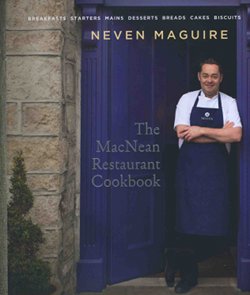 The Christmas crop of food books is exceptionally heavy this season - I was tempted to test this, literally, on the bathroom scales as there’s been a move towards posh hardbacks since the recession started and the difference in weight is very noticeable.
The Christmas crop of food books is exceptionally heavy this season - I was tempted to test this, literally, on the bathroom scales as there’s been a move towards posh hardbacks since the recession started and the difference in weight is very noticeable.
Not great news for the postman perhaps but, on the upside, these weighty tomes are impressive enough to make extremely presentable gifts for very little money – and any of the books featured here would fit the bill handsomely. High productions standards and great photography (often including evocative background imagery of Ireland and Irish life) are among the features that make them especially covetable – and, my, isn’t the young photographer Joanne Murphy quite the star this year?
Of the Irish interest cookbooks, top of my pile has to be Neven Maguire’s new book The MacNean Restaurant Cookbook (Gill & Macmillan, hardback €24.99) which celebrates 30 years of his family’s iconic restaurant in Blacklion, Co Cavan. It’s a special tribute to his late mother, the wonderful Vera, who first taught him to cook and was a huge influence, instilling in him many of the principles that became his driving passion and the reasons for his extraordinary success. Vera worked in the kitchen with him until 2001 when he took over the family business, which he now runs with his wife Amelda and a dedicated young team that he values highly – and praises to the rooftops at every available opportunity. For more on this remarkable book see this month’s main Cookery Feature.
Books produced for charity are particularly special and one that would make a beautiful Christmas present is SABA: The Cookbook (published by SABA, hardback €30 from Saba, Saba To Go, Easons other good bookshops). Written by owner and former RAI (Restaurants Association of Ireland) president, Paul Cadden and executive chef Taweesak Trakoolwattana (Tao), it is not only a lovely collection of authentic Thai and Vietnamese dishes but also the story of Saba’s first five years; all proceeds go to The Bone Marrow Transplant Unit in Our Lady’s Children’s Hospital, Crumlin and to The Thai Red Cross Society.
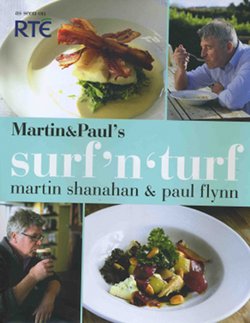 Martin Shanahan and Paul Flynn’s Martin&Paul’s Surf’n’Turf (Quadrille hardback £17.99/€22.99; photography by Simon Wheeler) is just what’s needed to get more of us into the kitchen and, I suspect, will have particular appeal to male cooks which is all to the good. Martin and Paul, respective proprietors of Fishy Fishy Restaurant & Café in Kinsale Co Cork and the Tannery restaurant and cookery school in Dungarvan, Co Waterford, were both well-established and highly respected chefs long before they hit the small screen but it’s the runaway success of RTE’s ‘Martin’s Mad About Fish’ and, more recently, ‘Martin&Paul’s Surf’n’Turf’ that has put the spotlight on them. And how fortunate it is for Ireland’s cooks that things have turned out this way, as both are great champions of seasonal local produce and their cooking style is gutsy and down to earth. For samples of two typically accessible dishes, see this month’s In Season (hill lamb) and Special Irish Foods & The People Who Make Them (Gubbeen bacon).
Martin Shanahan and Paul Flynn’s Martin&Paul’s Surf’n’Turf (Quadrille hardback £17.99/€22.99; photography by Simon Wheeler) is just what’s needed to get more of us into the kitchen and, I suspect, will have particular appeal to male cooks which is all to the good. Martin and Paul, respective proprietors of Fishy Fishy Restaurant & Café in Kinsale Co Cork and the Tannery restaurant and cookery school in Dungarvan, Co Waterford, were both well-established and highly respected chefs long before they hit the small screen but it’s the runaway success of RTE’s ‘Martin’s Mad About Fish’ and, more recently, ‘Martin&Paul’s Surf’n’Turf’ that has put the spotlight on them. And how fortunate it is for Ireland’s cooks that things have turned out this way, as both are great champions of seasonal local produce and their cooking style is gutsy and down to earth. For samples of two typically accessible dishes, see this month’s In Season (hill lamb) and Special Irish Foods & The People Who Make Them (Gubbeen bacon).
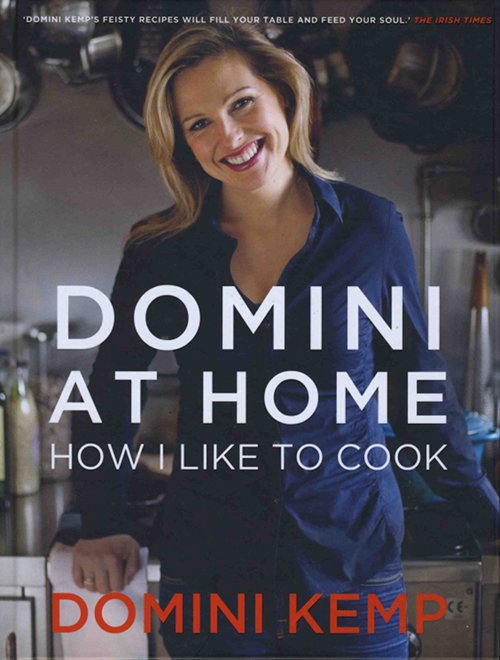 Together with her sister Peaches, Domini Kemp runs the popular Itsa…restaurants (and other food companies) and her food column in the Irish Times Magazine has a great following, so her third cookbook, Domini at Home – How I Like to Cook (Gill & Macmillan hardback €22.99) will be eagerly snapped up by fans who enjoy her honest, no-nonsense style and her way of simplifying dishes to get them on the table faster without compromising on taste. And, clearly conscious of the fact that so many cookery books end up being mainly ornamental, she wants her recipes to ‘encourage everyone get out the knives and cooking board and cook some dinner.’ Joanne Murphy’s photographs show the stylish do-ability of Domini’s dishes, and it’s especially great to see dishes that will do two nights (or next day’s lunch boxes) and, unusually, a good range of vegetarian dishes too.
Together with her sister Peaches, Domini Kemp runs the popular Itsa…restaurants (and other food companies) and her food column in the Irish Times Magazine has a great following, so her third cookbook, Domini at Home – How I Like to Cook (Gill & Macmillan hardback €22.99) will be eagerly snapped up by fans who enjoy her honest, no-nonsense style and her way of simplifying dishes to get them on the table faster without compromising on taste. And, clearly conscious of the fact that so many cookery books end up being mainly ornamental, she wants her recipes to ‘encourage everyone get out the knives and cooking board and cook some dinner.’ Joanne Murphy’s photographs show the stylish do-ability of Domini’s dishes, and it’s especially great to see dishes that will do two nights (or next day’s lunch boxes) and, unusually, a good range of vegetarian dishes too.
RECIPE: Domini’s Leek & Bread Pudding
“I love a good veggie dish that works as both a one-pot supper wonder and as part of a Sunday lunch affair instead of spuds, which, while I adore them, I get fed up with every now and then.
This leek pudding comes from Thomas Keller of The French Laundry, though in his one he uses brioche, which I replace with a good-quality white loaf. I imagine the brioche cubes would make it even more luscious and rich, but to be honest the plain ones work really well.
I highly recommend serving it on its own midweek or as part of something more lavish on a Sunday. It would be gorgeous with roast chicken, I bet.”
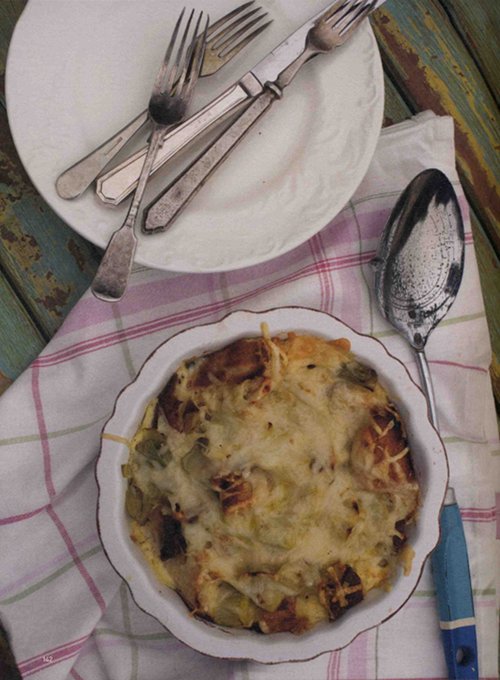 Serves 6-8
Serves 6-8
6 really big leeks
50 g butter
Olive oil
Salt and pepper
3 cloves garlic, peeled and sliced
Few sprigs thyme
1 loaf decent white bread (about 600 g)
500 ml milk
500 ml cream
3 eggs
Pinch nutmeg (optional)
250g Gruyère OR Cheddar cheese, grated
Preheat the oven to 170°C.
Chop the leeks into 2-3 cm slices and then sweat with the butter and a splash of olive oil in a large saucepan with a lid on it for 10 to 15 minutes until good and soft.
Season really generously, and add the garlic and thyme.
While this is cooking, cut the bread into 3 cm cubes and bake in the oven for 10 minutes or so until golden brown. I would also season these lightly. Beat together the milk, cream and eggs. You can grate or add a pinch of nutmeg to this if you like.
When the leeks are good and soft, add the toasted bread cubes, mix well and then spoon into a suitably sized gratin dish. The leeks should come quite high up the dish, but you do need to allow for the cream mixture to go in, so leave enough room. Pour the cream mixture on top and then top with cheese. Leave it for 15 minutes to an hour or so, to soak.
Bake for about an hour until the top is golden brown. Allow to cool a little so the filling can settle, and then serve.
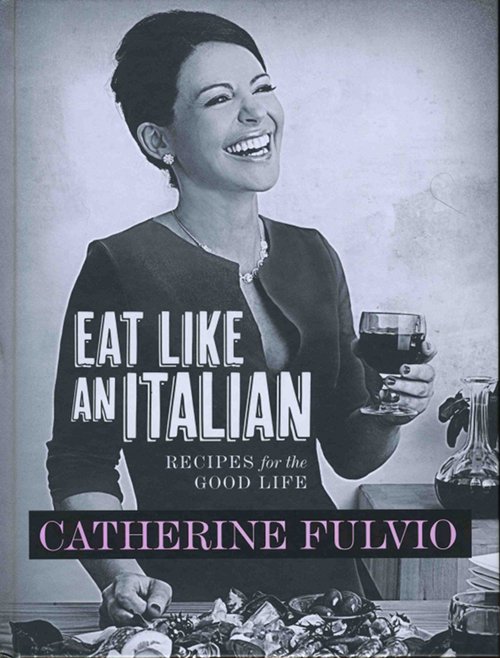 Fans who love the warm style and accessible recipes of Catherine Fulvio, the bubbly TV chef and proprietor of Ballyknocken Cookery School and B&B in Co Wicklow, will relish Eat Like An Italian (Gill & Macmillan hardback, €22.99) which expands on the links between Irish and Italian culture that she has developed through her husband, Claudio, and his family.
Fans who love the warm style and accessible recipes of Catherine Fulvio, the bubbly TV chef and proprietor of Ballyknocken Cookery School and B&B in Co Wicklow, will relish Eat Like An Italian (Gill & Macmillan hardback, €22.99) which expands on the links between Irish and Italian culture that she has developed through her husband, Claudio, and his family.
This book is a celebration of the Italian philosophy that puts ‘the good life’ first, with food a top priority – and, as she points out, Italy is one of the slimmest nations in Europe and the Mediterranean diet is arguably the healthiest in the world...
Typically, Catherine encourages us to embrace the Italian lifestyle and food culture by using our own local seasonally fresh produce, prioritising our mealtimes by making them routine and including friends and family, taking daily exercise and a drink in moderation. Sounds good to me – and with great photographs by Harry Weir, everything looks good as it promises to taste.
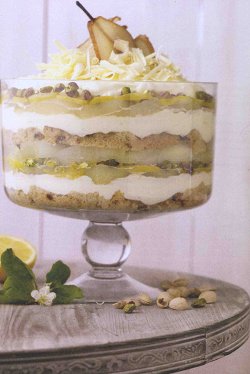 RECIPE: Catherine Fulvio’s Lemon & Panettone Trifle
RECIPE: Catherine Fulvio’s Lemon & Panettone Trifle
ZUPPA INGLESE Dl LIMONE E PANETTONE / SERVES 4-6
“There always seems to be some panettone left over, delicious as it is. it can dry out, so this is a good way to use it with sweet results. When poaching the pears, try adding a few pieces of lemon zest. It not only gives a wonderful flavour to the stock syrup, but helps to keep the pears from discolouring.”
Catherine gives a slightly ‘Irish’ version of panettone in ‘Eat Like An Italian’ and this refreshing trifle is the perfect partner. Her Keeping it Local hints are a welcome feature of the book, although you would be hard pushed to find Coisreal Longueville to poach the pears in these days – alternatively you could use their beautiful new Longueville House Cider, or of course a light Italian white wine.
3 pears, peeled, cored and sliced into wedges
100g caster sugar
400ml water
100g mascarpone
120ml natural yoghurt
120ml cream
1 lemon, zest only
5 tbsp icing sugar
100ml poaching syrup from the pears
3 tbsp amaretto
8-10 slices of panettone
2 tbsp chopped pistachio nuts, plus extra to decorate
white chocolate shavings to decorate
1 To poach the pears, heat the sugar and water in a saucepan until the sugar has dissolved. Add the pears and simmer for about 15 minutes, until cooked through. Set aside.
2 Lightly whip the mascarpone, yoghurt, cream, lemon zest and icing sugar together in a bowl.
3 In a separate bowl, combine the poaching syrup and amaretto.
4 Layer a few slices of pear in- pretty glasses or a large trifle bowl and spoon over the lemon yoghurt cream. Add a layer of panettone, drizzle over some of the amaretto poaching liquid and sprinkle over a few nuts. Continue layering, ending with the yoghurt mascarpone cream.
5 Decorate with pear slices, white chocolate shavings and a few nuts.
KEEPING IT LOCAL: Select a few great-looking conference pears at the market stand. Poach in Coisreal Longueville, a delicious crisp white wine from the O'Callaghan family in Longueville House, Cork.
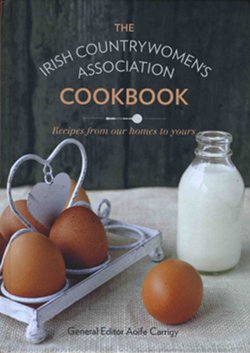 Casual browsers may be surprised to find Edward Hayden among contributors to the The Irish Countrywomen’s Association Cookbook (Gill & Macmillan hardback, €22.99), but the popular Kilkenny chef is so well known to members from the ICA events that he supports that he’s earned his stripes as a sort of ‘honorary member’... Which is a comfortable place to be as the ICA has been associated with good food in Ireland for over a century, and especially since 1947 when they set up the famous network of country markets to sell home-produced food – which are still going strong today.
Casual browsers may be surprised to find Edward Hayden among contributors to the The Irish Countrywomen’s Association Cookbook (Gill & Macmillan hardback, €22.99), but the popular Kilkenny chef is so well known to members from the ICA events that he supports that he’s earned his stripes as a sort of ‘honorary member’... Which is a comfortable place to be as the ICA has been associated with good food in Ireland for over a century, and especially since 1947 when they set up the famous network of country markets to sell home-produced food – which are still going strong today.
“Think of it as akin to having not just your own mammy on speed dial, but rather a whole host of mammies and grannies from all over the country, each sharing their own words of wisdom and precious first hand experiences.” That reassuring thought should alone be enough to make this book a best seller, and why not. It’s the first national ICA cookbook produced by this much-loved national institution – and, knowing that ‘In today’s busy modern lives, the importance of a family meal cannot be overstated’ it will surely prove, as they say themselves, ‘an invaluable resource for the next generation of home-makers: those novice cooks who might call home for that foolproof recipe might now reach for this book instead.’
Professionally produced, with Aoife Carrigy as General Editor and photography by Joanne Murphy, you’ll find a pleasing collection of ICA members’ favourites old and new, many of them handed down through generations – and including some festive treats such as Roast Goose With Damson & Apple Sauce (Brid Malone, Laois) and an Egg-Free Christmas Pudding (Mary Fitzgerald, Wexford).
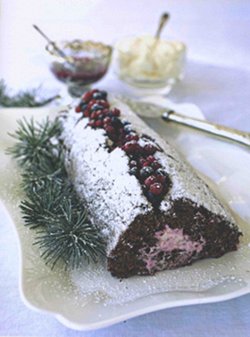 ICA Cookbook RECIPE: Cranberry & Chocolate Roulade
ICA Cookbook RECIPE: Cranberry & Chocolate Roulade
Recipe from: Brid Malone, Laois. Mother of five, walker and swimmer.
“The tart cranberries give this chocolate roulade a refreshing edge after a rich meal. I like to serve it after my Christmas dinner of roast goose with damson sauce (recipe given in book) but really it is delicious any time of year. This recipe won first prize in the 1998 ICA All-Ireland Christmas Recipe Competition.” Serves 8-10
4 eggs, separated
140g (5oz) sugar
40g (1½ oz) cocoa powder
for the filling
225g (8oz) fresh cranberries (or frozen, defrosted fully)
3 tablespoons orange juice
85g (3oz) caster sugar
275ml 1/2 pint) cream, whipped stiffly
2 tablespoons Grand Marnier
to garnish
icing sugar
sprig of holly
mixed frozen berries defrosted (optional)
You will need
20cm x 30cm (8in x 12in)
Swiss roll tin
1. Preheat oven to 180ºC/350ºF/Gas 4. Grease Swiss roll tin and line with baking parchment.
2. In a large bowl, whisk egg yolks with sugar until pale in colour and very thick and light in texture. Sieve over the cocoa and gently fold in using a metal spoon.
3. Whisk the egg whites until just stiff but not dry. Fold a third of this into the roulade mix. Repeat with the second third, and finally fold in the remaining egg white. Pour into prepared tin and bake in preheated oven for 18-20 minutes or until well risen and springy to touch. Cover with a damp tea towel and leave to cool in tin.
4. To make the filling, gently simmer the cranberries, orange juice and sugar in a saucepan for about 10 minutes or until tender. Remove from the heat and allow to cool before folding into the whipped cream together with the Grand Marnier.
5. Turn the cooled roulade onto a sheet of baking parchment dusted with icing sugar. Trim the edges and spread the cream mixture over the roulade. Roll up gently but don't worry if it cracks slightly.
6. Chill for at least two hours before serving. Dust with more icing sugar and decorate with defrosted berries and a sprig of holly.
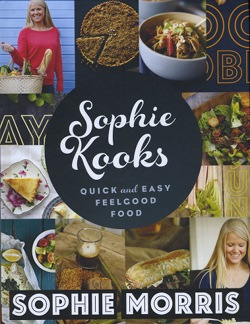 Co-founder of Kooky Dough, a young company that makes deliciously natural cookies-to-bake-quickly-at home, Sophie Morris and her business partner, Graham Clarke, famously turned down investment offers on ‘Dragons’ Den’ a while back - and then went on to make a huge success of their business.
Co-founder of Kooky Dough, a young company that makes deliciously natural cookies-to-bake-quickly-at home, Sophie Morris and her business partner, Graham Clarke, famously turned down investment offers on ‘Dragons’ Den’ a while back - and then went on to make a huge success of their business.
Sophie Kooks Quick and Easy Feelgood Food (Gill & Macmillan, hardback €22.99) is Sophie’s first book and the same principles of speed and quality applied to her business are seen in her approach to home cooking. She says that making a nourishing home-cooked meal every day is key to staying on top of her hectic life: ‘Why reach for the take-away menu when you can assemble Dad’s Chinese Beef in minutes?’ A girl after my own heart.
And, while emphasising that she is not a chef, she is a graduate of Ballymaloe Cookery School and this 28-year old knows her stuff. I like a lot of things about this attractive book, especially the month-by-month format which helps cooks in hurry to work with the seasons.
Most of the recipes are in the ‘real food’ camp, so these cupcakes are not a very typical choice (and, personally, I think we’re cup-caked out at this stage), but they are a very pretty variation on Christmas baking.
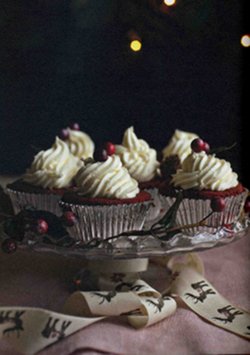 RECIPE: Sophie’s Christmassy Red Velvet Cupcakes
RECIPE: Sophie’s Christmassy Red Velvet Cupcakes
It's not so much the taste of these cupcakes but the look of them that makes them so Christmassy. The gorgeous, deep-red colour of the sponge alongside the snow-white cream cheese icing makes the cupcakes seem very luxurious. Perfect little Christmas treats...
65g butter, softened (preferably unsalted)
155g caster sugar
1 large egg
½ teaspoon vanilla extract
1 tablespoon cocoa powder
2 tablespoons red food colouring
120ml buttermilk, divided
150g plain flour
½ teaspoon baking powder
salt
1 teaspoon white vinegar
½ teaspoon bread soda (bicarbonate of soda)
For the icing
300g icing sugar, sieved
50g butter, softened (preferably unsalted)
120g cream cheese
Preheat the oven to l80ºC/350'F/gas 4. Line a muffin tin with 12 paper cases.
Cream the butter and sugar in a large bowl with an electric beater, until pale and fluffy. Add the egg and vanilla extract and beat until combined.
In a small bowl, mix the cocoa powder with the food colouring to make a very thick paste. Add this paste to the butter and egg mixture, and beat well to combine. Pour in half the buttermilk and beat again until well combined.
Sift the flour, baking powder arid a pinch of salt into another bowl. Pour half this flour mix into the batter in the large bowl and beat well. Add the remaining buttermilk and beat again. Now add the remaining flour mix and beat well for a few minutes.
Place the vinegar and bread soda in a small bowl and stir to combine. Add this mixture to the cake hatter and beat well for a few minutes.
Use a spoon to divide the cake batter evenly among the baking cases, so that they are two-thirds full. Bake fo r20 minutes, until springy lo the touch and a skewer inserted comes out clean. Leave the cupcakes to cool in the tray for a few minutes before removing them to a wire rack.
Meanwhile, make the icing. Beat the icing sugar and butter in a medium bowl with an electric beater until combined. Add the cream cheese and beat again. Beat the mixture for about 5minutes to get a really fluffy, pale icing.
When the cupcakes have cooled fully, dollop a spoon of icing on top of each one. Spread the icing but make sure you don't cover the cupcakes completely the pretty red sponge must be visible.
You could also use a piping bag to put a pretty swirl of icing on top of each cupcake. And to make them extra festive, you could sprinkle them with some red edible glitter.
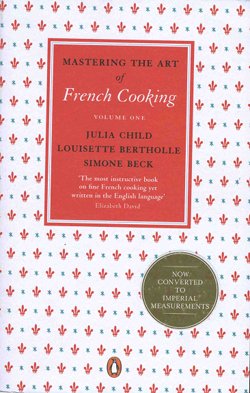 Classic re-issues are always of interest as it’s fascinating to observe the old faithfuls being introduced to a new generation. Penguin have issued a 2-volume set of Julia Child’s Mastering the Art of French Cooking to mark the 50th anniversary of this iconic work, written with partners in her Paris cookery school L’Ecole des Trois Gourmandes, Simone Beck and Louisette Bertholle; it’s available as a boxed hardback set (£50/€56) or individual paperbacks (£12.99/£15.99).
Classic re-issues are always of interest as it’s fascinating to observe the old faithfuls being introduced to a new generation. Penguin have issued a 2-volume set of Julia Child’s Mastering the Art of French Cooking to mark the 50th anniversary of this iconic work, written with partners in her Paris cookery school L’Ecole des Trois Gourmandes, Simone Beck and Louisette Bertholle; it’s available as a boxed hardback set (£50/€56) or individual paperbacks (£12.99/£15.99).
Elizabeth David was a fan it remains the most highly respected book on classic French cooking in the English language. It’s amusing to note the cover sticker announcement ‘Now converted to Imperial Measurements’. This reminds me of a new edition of Mrs Beeton that was brought out some years ago and converted to metric measurements in anticipation of a changeover that never really happened. It was a disaster and later editions have offered both.
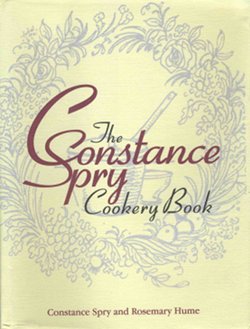 The new edition of what many regard as the ultimate kitchen bible, The Constance Spry Cookery Book (Grubb Street, hardback £30), also gives dual imperial/metric measurements and this thumping great volume running to over 1,000 pages is fantastic value.
The new edition of what many regard as the ultimate kitchen bible, The Constance Spry Cookery Book (Grubb Street, hardback £30), also gives dual imperial/metric measurements and this thumping great volume running to over 1,000 pages is fantastic value.
Although some of the household tips and practical references have been overtaken by technology and may seem quaint, this book – once on the wedding list of every bride who aspired to run a good kitchen and entertain with confidence – remains a sound all round reference with a wide-ranging education between its covers.
Bar a few diagrams, neither of these classics is illustrated by the way, but they more than make up for lack of visual appeal through interesting content and the clarity of the language – something not often found these days, as contemporary books rely so heavily on photography to illustrate their points.
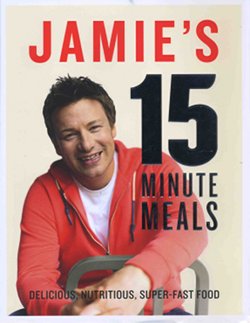 Of this season’s mainstream UK publications, several sure-fire best sellers are weighing down my desk, including Jamie’s 15 Minutes Meals (Michael Joseph hardback, £30), which – despite the fact that you’d be hard pushed to make most of these meals in the promised time frame - will probably be even more popular than usual in Ireland thanks to the opening of Jamie Oliver’s first Irish restaurant, in Dundrum, recently.
Of this season’s mainstream UK publications, several sure-fire best sellers are weighing down my desk, including Jamie’s 15 Minutes Meals (Michael Joseph hardback, £30), which – despite the fact that you’d be hard pushed to make most of these meals in the promised time frame - will probably be even more popular than usual in Ireland thanks to the opening of Jamie Oliver’s first Irish restaurant, in Dundrum, recently.
But whether or not the timing is strictly achievable, these are easy colourful multi-cultural dishes and every page is imbued with Jamie’s usual enthusiasm, health consciousness (calorie counts for all dishes as well as his trademark emphasis on wholesome fresh ingredients) and ambition to educate - especially by impressing on young cooks the importance of the kitchen skills and good organisation which allow you to ‘own your kitchen’ (his comments on clutter are, ahem, instructive) and cook fast...
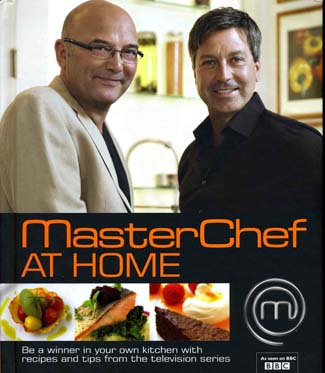 Surprisingly perhaps, Masterchef Everyday (Dorling Kindersley, £20/£25) shares similar territory to Jamie Oliver, with John Torode and Gregg Wallace bringing together a range of former MasterChef contestants’ dishes in a broadly educational way (‘Everything you need to become a MasterChef’), and with 20 of the 130 recipes simplified for ‘everyday’.
Surprisingly perhaps, Masterchef Everyday (Dorling Kindersley, £20/£25) shares similar territory to Jamie Oliver, with John Torode and Gregg Wallace bringing together a range of former MasterChef contestants’ dishes in a broadly educational way (‘Everything you need to become a MasterChef’), and with 20 of the 130 recipes simplified for ‘everyday’.
Whether your everyday is the same as their everyday is up to you - but that strikes me as being rather contradictory anyway - the whole point of MasterChef is to do with achieving stratospheric standards, there are masses of books already dealing very well with everyday.
Whatever about all that, it’s an attractive, good tempered and informational book and great value – and, like Jamie’s 15 Minute Meals (and Paul&Martin’s Surf’nTurf), I suspect it would be particularly well received by the men on your gift list who have an interest in cooking.
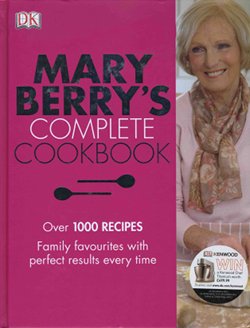 Mary Berry, on the other hand – a ‘kitchen bible’ author if ever there was one – has a more feminine appeal and I’d say Mary Berry’s Complete Cookbook (DK hardback £25) would take its place very happily on the bookshelf of any family kitchen where (let’s be honest) mum is usually the everyday cook.
Mary Berry, on the other hand – a ‘kitchen bible’ author if ever there was one – has a more feminine appeal and I’d say Mary Berry’s Complete Cookbook (DK hardback £25) would take its place very happily on the bookshelf of any family kitchen where (let’s be honest) mum is usually the everyday cook.
It’s one of those great all-round references with a huge range of recipes, confidence-inspiring step-by-step photos, ‘Cook’s know-how’ tips and ‘Healthy notes’ that make you feel you have an experienced auntie in the kitchen with you.
Classic situations like cooking for Christmas are very well covered (I’ll come back to The Dinner next month) and fans of The Great British Bake Off will know that all kinds of baking are especially strong...
Christmas Pudding needs a few weeks to mature, if possible, so this is a good recipe to make now.
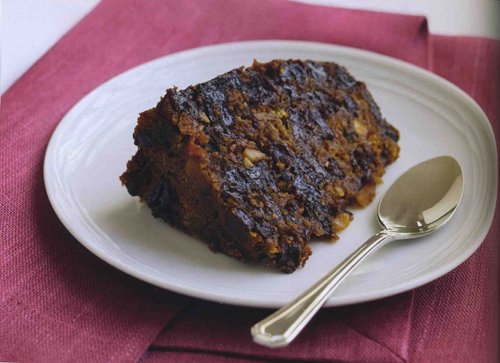 Mary Berry’s Christmas pudding
Mary Berry’s Christmas pudding
This is a rich, dark pudding, laden with dried fruit, spices, and alcohol - the traditional way to finish the festive meal.
SERVES 8-10 522-418 CALS PER SERVING
90g (3oz) self-raising flour
125g (4 oz) shredded vegetable suet or grated chilled butter
30g (1 oz) blanched almonds, shredded
125g (4oz) carrot, grated
250g (8 oz) raisins
125g (40z) currants
125g (4 oz) sultanas
125g (4 oz) fresh breadcrumbs
¼ tsp grated nutmeg
60g (2 oz) mixed candied peel, chopped
90g (3 oz) light muscovado sugar
grated zest and juice of 1 lemon
2 eggs, beaten
butter for greasing
75ml (2½ fl oz) dark rum or brandy
brandy butter (see below) to serve
1x1.25 litre (2 pint) pudding bowl
1 In a large bowl, combine the flour, suet or butter, almonds, carrots, raisins, currants, sultanas, breadcrumbs, nutmeg, candied peel, sugar and lemon zest. Add the lemon juice and eggs, and stir until well combined.
2 Lightly butter the pudding bowl. Spoon in the pudding mixture and level the surface
3 Cover with buttered greaseproof paper, then foil, both pleated in the middle. Secure the paper and foil in place by tying string under the rim of the bowl.
4 Put the bowl into a steamer or saucepan of simmering water, making sure the halfway up the side the bowl. Cover and steam, topping up with boiling water as needed, for about 6 hours.
5 Remove the bowl from the steamer or pan and leave to cool. Remove the paper and foil covering. Make a few holes in the pudding with a fine skewer and pour in the rum or brandy.
6 Cover the pudding with fresh greaseproof paper and foil. Store in a cool place for up to 3 months
7 To reheat for serving, steam the pudding for 2-3 hours. Serve at once, with brandy butter. Make your own brandy butter by creaming together 250g (8 oz) each of unsalted butter and caster sugar or icing sugar, and 90ml (3 fl oz) brandy. The brandy butter can be frozen for up to 3 months.





There are currently no comments
Leave a comment
Not a member? Register for your free membership now!
Or leave a comment by logging in with: